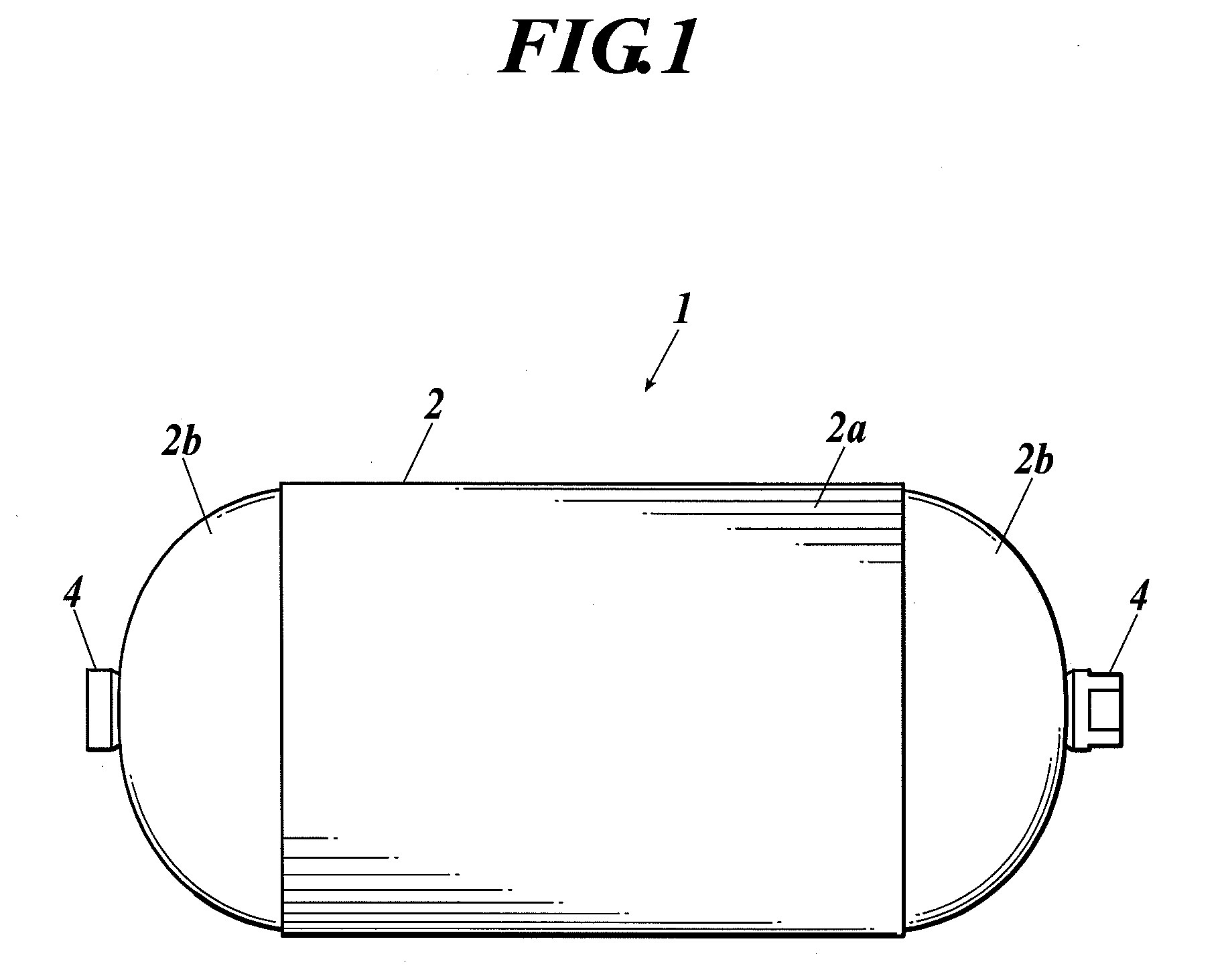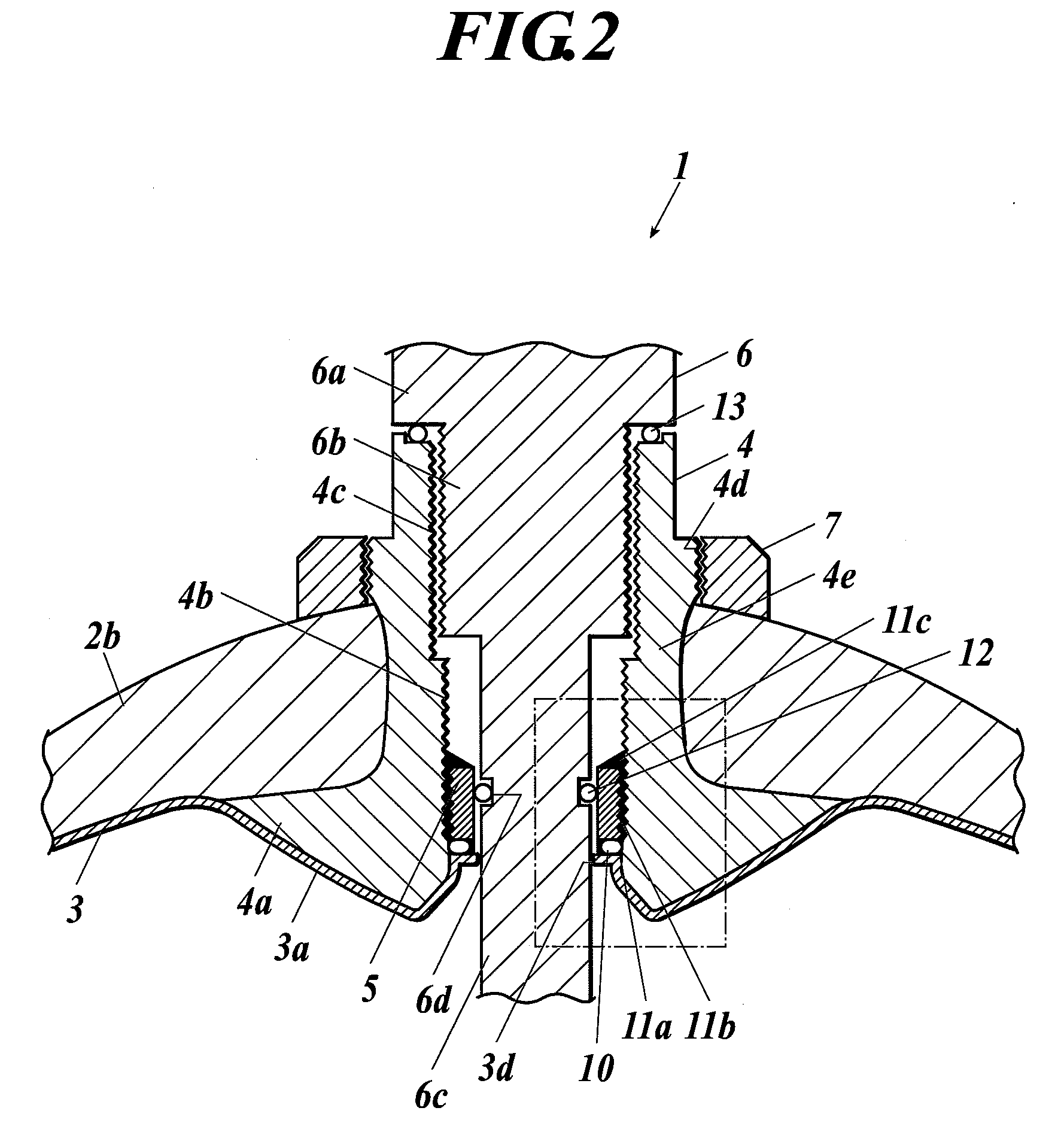Pressure-Resistant Container
a container and pressure-resistant technology, applied in the direction of container discharging methods, vessel construction details, transportation and packaging, etc., can solve the problems of gap generation, creeping in the resin of the inner shell, and insufficient gas sealing properties of the conventional gas tank, etc., to achieve high pressure resistance properties of the container
- Summary
- Abstract
- Description
- Claims
- Application Information
AI Technical Summary
Benefits of technology
Problems solved by technology
Method used
Image
Examples
first embodiment
[0053]First, the first embodiment of the present invention will be described with reference to FIGS. 1 to 3.
[0054]FIG. 1 is an outline view of the entire pressure-resistant container according to the first embodiment of the present invention.
[0055]As shown in FIG. 1, the pressure-resistant container 1 of the present embodiment comprises an outer shell 2 and mouth rings 4. The outer shell 2 is made of a composite material of a fiber reinforced resin such as CFRP, and is composed of a cylinder part 2a and dome parts 2b and 2b continuing from both ends of the cylinder part 2a. The outer shell 2 covers an inner shell (omitted from the drawing). The mouth rings 4 are provided at the peak parts of the dome parts 2b and 2b. Only one mouth ring may be provided.
[0056]FIG. 2 is a sectional view of a mouth ring portion of the pressure-resistant container 1. FIG. 3 is a partially enlarged view of FIG. 2. As shown in FIG. 2 or 3, an opening 3d connected to the mouth rings 4 is formed at the inne...
second embodiment
[0110]Next, a second embodiment of the present invention will be described with reference to FIG. 4. FIG. 4 is a sectional view of a mouth ring portion of the pressure-resistant container according to the second embodiment of the present invention. The pressure-resistant container 20 of the embodiment is different from the pressure-resistant container 1 of the first embodiment in that the O-ring 10 constituting the first seal is excluded and that the first seal is composed only with the liquid sealant 11a. The liquid sealants 11b and 11c are not shown. However, they may be provided.
[0111]As described above, in the case of the pressure-resistant container 1 of the first embodiment, the reliability of the sealing is improved by using the liquid sealant 11a in addition to the O-ring 10 as the first seal.
[0112]When the O-ring 10 is applied, there is an advantage that an uniform sealing part can be obtained comparing to when only the liquid sealant 11a is used. However, in the case where...
third embodiment
[0113]Next, a third embodiment of the present invention will be described with reference to FIG. 5. FIG. 5 is a sectional view of a mouth ring portion of the pressure-resistant container according to the third embodiment of the present invention. The pressure-resistant container 30 of the embodiment is different from the pressure-resistant container 20 of the second embodiment in that the first seal is a liquid sealant 31 and that the liquid sealant 31 peripherally contacts with and covers the inner peripheral surface of the mouth ring 4 which is exposed between the inner shell 33 and the pressing member 5 and periphery of the opening of the inner shell 3 and does not contact with the pressing member 5. It is preferable that the liquid sealants 11b and 11c are provided to the pressing member 5 similarly as in the first embodiment, although they are not shown.
[0114]As shown in FIG. 5, the inner shell 33 covers along the mouth ring 4 to the circumference of the opening of the inner sh...
PUM
| Property | Measurement | Unit |
|---|---|---|
| pressures | aaaaa | aaaaa |
| pressures | aaaaa | aaaaa |
| pressure | aaaaa | aaaaa |
Abstract
Description
Claims
Application Information
 Login to View More
Login to View More - R&D
- Intellectual Property
- Life Sciences
- Materials
- Tech Scout
- Unparalleled Data Quality
- Higher Quality Content
- 60% Fewer Hallucinations
Browse by: Latest US Patents, China's latest patents, Technical Efficacy Thesaurus, Application Domain, Technology Topic, Popular Technical Reports.
© 2025 PatSnap. All rights reserved.Legal|Privacy policy|Modern Slavery Act Transparency Statement|Sitemap|About US| Contact US: help@patsnap.com



